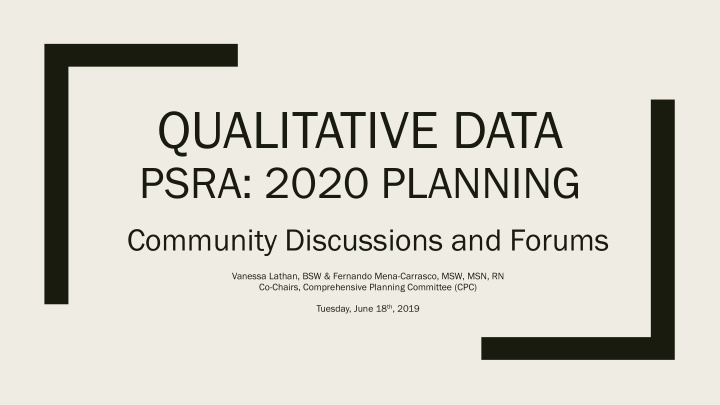



QUALITATIVE DATA PSRA: 2020 PLANNING Community Discussions and Forums Vanessa Lathan, BSW & Fernando Mena-Carrasco, MSW, MSN, RN Co-Chairs, Comprehensive Planning Committee (CPC) Tuesday, June 18 th , 2019
What is the CPC and what are the members charged with? ■ Standing committee of the Greater Baltimore HIV Health Services Planning Council. ■ Charged with: – developing the comprehensive/integrated plan, – identifying trends and needs for planning, and – overseeing the logistics of PSRA. ■ Members 2018-2019: – Dale Brewer, Markton Cole, Carlton Gross, Vanessa Lathan, Fernando Mena-Carrasco, Martin McEnrue, Kemahn Jones, Akil Patterson, Carlton Smith, and Brande Ward.
How did we get here? ■ PSRA 2018 – “Churning of patients” who fall in/out of care ■ CPC Summer 2018-Summer 2019 – Identification of unmet need - objective & subjective data – Led to exploration of models that assertively engage HIV+ persons – Held 5 community discussions: ■ Assertive engagement models to improve access to care for PLWHAs (July 2018) ■ Reaching & Serving Latino Communities (October 2018) ■ Community Conversation on Engaging the Youth Population (November 2018) ■ Transgender Response Team (March 2019) ■ Community Discussion on Care Engagement of PLWHAs (March 2019)
How did we get here? ■ The CPC identified key populations based on MDH/BCHD reporting in 2017: – Young unger er people ages 20-39 accounted for 60.1% of the new diagnoses* ■ Of those with a viral load test, viral suppression was lowest among persons currently aged 13-19 and 20-29 years old (68.5%). ■ An additional 50.6% of persons aged 13-24 living with HIV in Maryland remain undiagnosed. – Hi Hispanics/L nics/Lat atino nos accounted for 10.2% of the 1,040 reported HIV diagnoses* ■ While Baltimore’s overall population diminished by 4.6% between 2000-2010, the Latino population grew by 134.7%** ■ An additional 17.6% of Latinos living with HIV in Maryland remain undiagnosed (2016)* – Persons who identify as tran ans s female les accounted for 1.3% of the new diagnoses* ■ 71.4% were linked to care within 1 month of diagnosis ■ 71.6% of those with a viral load were UD | HET: 84.9% | MSM: 84.4% *Center for HIV Surveillance, Epidemiology and Evaluation | Maryland Department of Health ** City of Baltimore, Hispanic Commission
Qualitative Data & Key Recommendations Community Forums ■ Youn unger ger peop ople: le: – Peer-designed, peer-delivered, peer-led social media messaging/marketing – Empowering youth through employment and leadership of public health programming around HIV/STIs. ■ Latino inos/His /Hispani anics: cs: – Increasing specialized case managers, system navigators, pharmacy technicians, and medical assistants in areas of EMA where Latinx patients are served, – Increasing language capability; medical and behavioral health services. ■ Persons sons who ho identi entify fy as trans: – Structural competence around gender-affirming medical services, – Equal prioritization of gender-affirming and HIV health services, – Trans-specific transitional housing (different safety thresholds), – Incorporate a multi-center navigator program for the transgender community. ■ Hire and promote trans individuals
What’s next? ■ Geriatric and aging populations ■ Deeper dive on emerging populations affected by the HIV epidemic – Language utilization – Gender-affirming care ■ EMA-wide assessment of service needs for people living with HIV
Recommend
More recommend